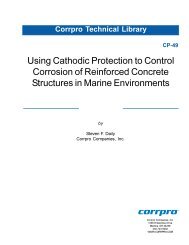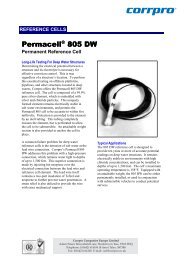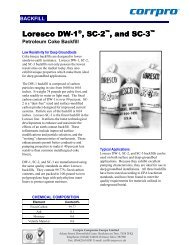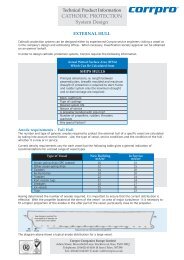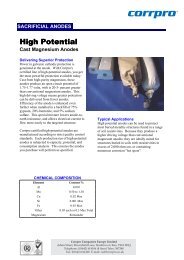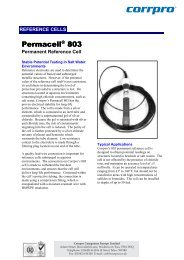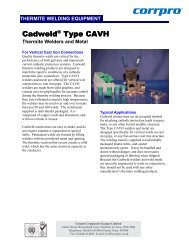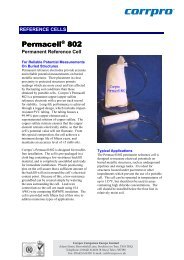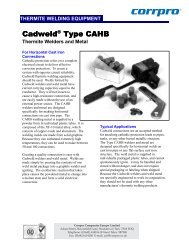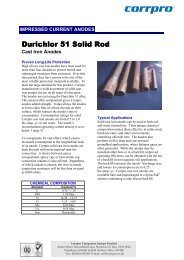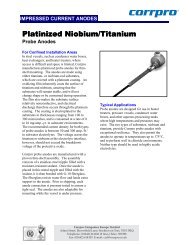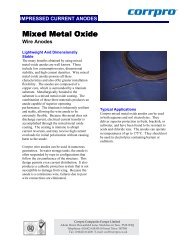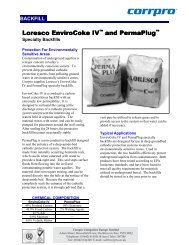18CP Corrosion in water systems an overview.pdf - Corrpro.Co.UK
18CP Corrosion in water systems an overview.pdf - Corrpro.Co.UK
18CP Corrosion in water systems an overview.pdf - Corrpro.Co.UK
Create successful ePaper yourself
Turn your PDF publications into a flip-book with our unique Google optimized e-Paper software.
<strong><strong>Co</strong>rrosion</strong> In<br />
Water Systems<br />
An Overview<br />
by<br />
David H. Kroon, P.E.<br />
CORRPRO <strong>Co</strong>mp<strong>an</strong>ies, Inc..<br />
Introduction<br />
<strong><strong>Co</strong>rrosion</strong> impacts the design, operation <strong>an</strong>d ma<strong>in</strong>ten<strong>an</strong>ce<br />
of every element of a <strong>water</strong> system. Water wells,<br />
treatment equipment, storage facilities <strong>an</strong>d pip<strong>in</strong>g <strong>systems</strong><br />
are all vulnerable to accelerated deterioration from<br />
corrosion. Numerous studies have been published that<br />
document causes of corrosion <strong>an</strong>d successful methods<br />
of control. 1-3<br />
The problems related to corrosion <strong>in</strong> <strong>water</strong> <strong>systems</strong> are<br />
not new. As early as 1939, the results from a survey<br />
performed by the Ill<strong>in</strong>ois State Water Survey <strong>in</strong>dicated<br />
that 41% of the <strong>water</strong> <strong>systems</strong> respond<strong>in</strong>g were experienc<strong>in</strong>g<br />
corrosion problems <strong>in</strong>volv<strong>in</strong>g well pumps, <strong>water</strong><br />
ma<strong>in</strong>s, storage facilities <strong>an</strong>d service l<strong>in</strong>es. 4 Over the<br />
years, the basic problems have ch<strong>an</strong>ged very little, although<br />
our underst<strong>an</strong>d<strong>in</strong>g <strong>an</strong>d technoogy for controll<strong>in</strong>g<br />
corrosion have improved signific<strong>an</strong>tly. 5<br />
<strong><strong>Co</strong>rrosion</strong> <strong>in</strong> <strong>water</strong> <strong>systems</strong> must be addressed by every<br />
operator to ensure economical supply of high quality<br />
<strong>water</strong> <strong>an</strong>d-safe operation of fire protection <strong>systems</strong>.<br />
By properly address<strong>in</strong>g corrosion mitigation through<br />
material selection, coat<strong>in</strong>gs <strong>an</strong>d cathodic protection,<br />
system life will be extended <strong>an</strong>d operational costs reduced.<br />
The economic benefits accrue to both the system<br />
operator <strong>an</strong>d ultimately the consumer.<br />
Impact of <strong><strong>Co</strong>rrosion</strong><br />
<strong><strong>Co</strong>rrosion</strong> impacts <strong>water</strong> <strong>systems</strong> <strong>in</strong> m<strong>an</strong>y more ways<br />
<strong>an</strong>d to a far greater degree th<strong>an</strong> m<strong>an</strong>y of us regularly<br />
consider (Table 1).<br />
TABLE 1<br />
Impact of <strong><strong>Co</strong>rrosion</strong><br />
1. <strong>Co</strong>stly System Repairs <strong>an</strong>d Replacements<br />
2. Disruption of Service<br />
3. Expensive Loss of Water<br />
4. Structural <strong>an</strong>d Environmental Damage<br />
5. Reduced Water Quality<br />
6. Improper Treatment<br />
7. Decreased System Capacity<br />
8. Impairment of Fire Protection Systems<br />
The construction of <strong>water</strong> <strong>systems</strong> is frequently f<strong>in</strong><strong>an</strong>ced<br />
through public revenue bonds with a 30 year term. The<br />
<strong>systems</strong> are often designed for a m<strong>in</strong>imum 40 year life,<br />
but neither the f<strong>in</strong><strong>an</strong>cial projections nor design life adequately<br />
account for the impact of corrosion. Expensive<br />
repairs <strong>an</strong>d replacements of system components<br />
c<strong>an</strong> f<strong>in</strong><strong>an</strong>cially cripple the <strong>water</strong> operator, <strong>an</strong>d directly<br />
cost the consumer far more th<strong>an</strong> necessary for <strong>an</strong> <strong>in</strong>ferior<br />
product. An <strong>in</strong>frastructure study <strong>in</strong> New York determ<strong>in</strong>ed<br />
that the direct cost of leak repair for the Wa-<br />
<strong><strong>Co</strong>rrpro</strong> <strong>Co</strong>mp<strong>an</strong>ies, Inc. Technical Paper 18 Page 1 of 7
ter Supply Bureau was $7,323 per failure. 6 An extreme<br />
case is the City of W<strong>in</strong>nipeg, where a $7.7 million program<br />
is required to reduce the leak frequency to 2200<br />
<strong>an</strong>nyally, which is equivalent to 1.8 leaks/mile of pipe<br />
per year. 7<br />
Disruption of service <strong>an</strong>d loss of <strong>water</strong> are also expensive<br />
with respect to public relations <strong>an</strong>d operat<strong>in</strong>g costs.<br />
The consumer pays for a cont<strong>in</strong>uous supply of high quality<br />
<strong>water</strong>. He/she has every right to be irate when service<br />
is <strong>in</strong>terrupted due to a system failure. Public safety<br />
is jeopardized because fire <strong>water</strong> <strong>systems</strong> are <strong>in</strong>operable.<br />
Purified <strong>water</strong> is also a precious commodity that deserves<br />
protection. The City of Boston, for example,<br />
loses half its fresh <strong>water</strong> each year due to failures, at <strong>an</strong><br />
<strong>an</strong>nual cost of $7 million.<br />
The <strong>in</strong>direct costs of a <strong>water</strong> leak <strong>in</strong>clude structural <strong>an</strong>d<br />
environmental damage, <strong>an</strong>d <strong>in</strong>creased public liability. The<br />
referenced study <strong>in</strong> New York <strong>in</strong>dicates that damage<br />
settlements average approximately $1460 per occurrence.<br />
In Houston, the city loses 20 to 30 percent of its<br />
purified <strong>water</strong> (70 million gallons daily) result<strong>in</strong>g <strong>in</strong> thous<strong>an</strong>ds<br />
of damage compla<strong>in</strong>ts each year for destroyed<br />
lawns, underm<strong>in</strong>ed pavements <strong>an</strong>d structural damage.<br />
Exposure to public liability is also <strong>in</strong>creased due to the<br />
potential for accidents as a direct result of <strong>water</strong> losses.<br />
Internal corrosion of pip<strong>in</strong>g <strong>systems</strong>, storage t<strong>an</strong>ks <strong>an</strong>d<br />
treatment equipment c<strong>an</strong> result <strong>in</strong> reduced <strong>water</strong> quality,<br />
improper treatment <strong>an</strong>d decreased system capacity.<br />
Rusty <strong>water</strong> or “red <strong>water</strong>” results from the suspension<br />
of hydrated iron oxide particles <strong>in</strong> the <strong>water</strong>. Tuberculation,<br />
which is caused by the build-up of corrosion products<br />
<strong>in</strong> the form of nodules, c<strong>an</strong> cause blockage <strong>an</strong>d<br />
dramatic <strong>in</strong>creases <strong>in</strong> the roughness of the <strong>in</strong>ternal pip<strong>in</strong>g<br />
surfaces, result<strong>in</strong>g <strong>in</strong> loss of system capacity. The<br />
<strong>water</strong> pressure is reduced at the po<strong>in</strong>t of use, which c<strong>an</strong><br />
create very serious supply problems for fire fight<strong>in</strong>g <strong>an</strong>d<br />
service to tall build<strong>in</strong>gs.<br />
<strong><strong>Co</strong>rrosion</strong> Rates<br />
The primary concern <strong>in</strong> <strong>an</strong>y <strong>water</strong> system is to evaluate<br />
the rate of corrosion <strong>an</strong>d determ<strong>in</strong>e whether the result<strong>an</strong>t<br />
deterioration is commensurate with the design life<br />
<strong>an</strong>d operat<strong>in</strong>g parameters. <strong><strong>Co</strong>rrosion</strong> is <strong>in</strong>evitable on<br />
all submerged, buried <strong>an</strong>d embedded metallic structures.<br />
The rate of corrosion is a key factor to <strong>an</strong>ticipate for<br />
new construction <strong>an</strong>d to <strong>an</strong>alyze on exist<strong>in</strong>g structures.<br />
<strong><strong>Co</strong>rrosion</strong> results from oxidation-reduction reactions<br />
occurr<strong>in</strong>g on a metal surface. Anodic (more electronegative)<br />
<strong>an</strong>d cathodic (more electro-positive) areas are<br />
created due to differences <strong>in</strong> the metal surface or differences<br />
<strong>in</strong> the electrolyte (soil, <strong>water</strong>, concrete, etc.). The<br />
potential difference between the <strong>an</strong>odic <strong>an</strong>d cathodic<br />
areas is the driv<strong>in</strong>g force <strong>in</strong> the corrosion cell. The resist<strong>an</strong>ce<br />
between the <strong>an</strong>ode <strong>an</strong>d cathode determ<strong>in</strong>es<br />
the flow of corrosion current accord<strong>in</strong>g to Ohms Law<br />
(E=IR). The corrosion current (charge tr<strong>an</strong>sfer/unit<br />
time), <strong>an</strong>d concentration of the current, def<strong>in</strong>es the rate<br />
at which metallic structures will fail due to corrosion.<br />
Oxidation, which is def<strong>in</strong>ed as the loss of electrons occurs<br />
at the <strong>an</strong>ode. The oxidation reaction at the <strong>an</strong>odic<br />
area is largely dissolution of the metal, which for ferrous<br />
alloys at ambient temperatures, would be primarily the<br />
oxidation of iron atoms to ferrous ions:<br />
Fe = Fe + + + 2e -<br />
Other <strong>an</strong>ode reactions <strong>in</strong>clude the evolution of oxygen<br />
<strong>an</strong>d the evolution of chlor<strong>in</strong>e. The most common reduction<br />
reaction <strong>in</strong> a neutral pH environment where the<br />
electrolyte is sufficiently aerated, is the reduction of oxygen<br />
<strong>in</strong> the presence of <strong>water</strong> to form hydroxyl ions:<br />
½ O 2<br />
+ H 2<br />
0 + 2e - = 20H -<br />
Notice that reduction <strong>in</strong>volves the ga<strong>in</strong> of electrons. Electrons<br />
must flow with<strong>in</strong> the metal circuit, from the <strong>an</strong>ode<br />
to cathode <strong>in</strong> a corrosion cell, <strong>an</strong>d positive ions must<br />
move away from the <strong>an</strong>ode, toward the cathode, <strong>in</strong> the<br />
electrolyte. Inherent to the electrochemical corrosion<br />
of metals are two natural phenomena that help reduce<br />
corrosion rates: passivation <strong>an</strong>d polarization.<br />
<strong><strong>Co</strong>rrpro</strong> <strong>Co</strong>mp<strong>an</strong>ies, Inc. Technical Paper 18 Page 2 of 7
Passivation occurs when a protective oxide layer is<br />
formed evenly over the metal surface, This phenomena<br />
is responsible for the corrosion resist<strong>an</strong>ce of alum<strong>in</strong>um<br />
<strong>in</strong> the atmosphere where a light grey oxide protects the<br />
metal substrate from further corrosion. It is also responsible<br />
for the corrosion resist<strong>an</strong>ce of sta<strong>in</strong>less steel <strong>in</strong> <strong>an</strong><br />
oxidiz<strong>in</strong>g environment where a very protective, <strong>an</strong>d <strong>in</strong>visible,<br />
film is formed prevent<strong>in</strong>g further oxidation of the<br />
metal. Note that the proper conditions must be satisfied<br />
<strong>an</strong>d the film must be uniformly formed to provide the<br />
protective barrier.<br />
Polarization is the tendency for the potential difference<br />
between the <strong>an</strong>ode <strong>an</strong>d cathode (driv<strong>in</strong>g force <strong>in</strong> the<br />
corrosion cell) to decrease with the flow of corrosion<br />
current. Activation polarization results from slow<br />
reactions on the metal surface <strong>an</strong>d concentration polarization<br />
results from slow molecular movement <strong>in</strong> the<br />
electrolyte. The actual rate at which metals corrode <strong>in</strong><br />
practice, are therefore largely governed by factors that<br />
either prevent or enh<strong>an</strong>ce passivation <strong>an</strong>d polarization.<br />
Table 2 lists a number of factors that <strong>in</strong>fluence the rate<br />
of corrosion <strong>in</strong> <strong>water</strong> <strong>systems</strong>. Although there are always<br />
exceptions to general rules, the rate of corrosion<br />
<strong>in</strong> <strong>water</strong> <strong>systems</strong> tends to be <strong>in</strong>creased by:<br />
* Direct connection between different metals or alloys<br />
* Stressed areas due to weld<strong>in</strong>g or cold work<strong>in</strong>g<br />
* High conductivity electrolyte (soil, <strong>water</strong> or concrete)<br />
* Aeration, dissolved oxygen, <strong>an</strong>d differences <strong>in</strong> oxygen<br />
concentration<br />
* High concentrations of chlorides <strong>an</strong>d sulfates versus<br />
carbonates<br />
* Acidic conditions<br />
* Elevated temperatures<br />
* High flow rates <strong>an</strong>d turbulence<br />
* Presence of sulfate reduc<strong>in</strong>g bacteria<br />
TABLE 2<br />
Factors Influenc<strong>in</strong>g the Rate of <strong><strong>Co</strong>rrosion</strong><br />
* Bimetallic <strong>Co</strong>uples<br />
* Stressed Areas<br />
* <strong>Co</strong>nductivity<br />
* Aeration<br />
* Ion <strong>Co</strong>ncentrations<br />
* pH<br />
* Temperature<br />
* Flow Rate <strong>an</strong>d Turbulence<br />
* Anearobic Bacteria<br />
The bi-metallic couples <strong>an</strong>d stressed areas <strong>in</strong>crease the<br />
potential difference between po<strong>in</strong>ts on the structures<br />
thereby <strong>in</strong>creas<strong>in</strong>g the driv<strong>in</strong>g force <strong>in</strong> the corrosion cell.<br />
The higher the conductivity, the lower the resist<strong>an</strong>ce<br />
between the <strong>an</strong>ode <strong>an</strong>d cathode, <strong>an</strong>d hence, the greater<br />
the corrosion current. All of the other factors contribute<br />
to <strong>in</strong>terfer<strong>in</strong>g with the polarization <strong>an</strong>d/or passivation of<br />
the metal surface.<br />
Types of <strong><strong>Co</strong>rrosion</strong><br />
Water <strong>systems</strong> are unique <strong>in</strong> that every conceivable type<br />
of corrosion c<strong>an</strong> occur. Table 3 lists a number of common<br />
forms <strong>an</strong>d mech<strong>an</strong>isms of corrosion that may be<br />
encountered <strong>in</strong> <strong>water</strong> <strong>systems</strong>.<br />
TABLE 3<br />
Types of <strong><strong>Co</strong>rrosion</strong><br />
* Uniform<br />
* Pitt<strong>in</strong>g<br />
* Stress <strong><strong>Co</strong>rrosion</strong><br />
* <strong><strong>Co</strong>rrosion</strong> Fatigue<br />
* Dissimilar Metal<br />
* <strong>Co</strong>ncentration Cells<br />
* Crevice<br />
* Stray Current<br />
* Dez<strong>in</strong>cification<br />
* Graphitization<br />
* Imp<strong>in</strong>gement Attack<br />
* Cavitation<br />
<strong><strong>Co</strong>rrpro</strong> <strong>Co</strong>mp<strong>an</strong>ies, Inc. Technical Paper 18 Page 3 of 7
The corrosion of a metal may appear uniform due to<br />
microscopic <strong>an</strong>odic <strong>an</strong>d cathodic areas formed on what<br />
appears to be a homogeneous metal surface. In actual<br />
fact, a metal consists of numerous gra<strong>in</strong>s, some of which<br />
will be <strong>an</strong>odic to adjacent gra<strong>in</strong>s due to the different<br />
metallurgical make up. For the same reason, it is not<br />
unusual for the most active (<strong>an</strong>odic) areas to be at the<br />
gra<strong>in</strong> boundaries.<br />
Pitt<strong>in</strong>g corrosion is <strong>in</strong>itiated by a localized <strong>an</strong>odic po<strong>in</strong>t<br />
on the metal surface. The penetration of the metal cont<strong>in</strong>ues<br />
at this po<strong>in</strong>t, because a relatively large area around<br />
the pit is cathodic to the pit itself. Pitt<strong>in</strong>g corrosion is<br />
commonly encountered at p<strong>in</strong>holes or flaws <strong>in</strong> dielectric<br />
coat<strong>in</strong>g <strong>systems</strong>. For steel <strong>an</strong>d sta<strong>in</strong>less steel, chloride<br />
ions are well known as a cause of pitt<strong>in</strong>g attack.<br />
Stress corrosion <strong>an</strong>d corrosion fatigue result from tensile<br />
stresses on the metal surface. Stress corrosion often<br />
takes place at the gra<strong>in</strong> boundaries where the metal<br />
has been stressed by cold work<strong>in</strong>g, or elevated temperature,<br />
such as with<strong>in</strong> the heat affected zone adjacent<br />
to a weld seam. <strong><strong>Co</strong>rrosion</strong> fatigue is generally a more<br />
rapid process, <strong>in</strong>volv<strong>in</strong>g alternat<strong>in</strong>g conditions of stress<br />
<strong>an</strong>d stress relief, that disturbs the formation of protective<br />
films <strong>in</strong> the <strong>an</strong>odic region.<br />
Dissimilar metal corrosion occurs due to the <strong>in</strong>terconnection<br />
of more active metal to a more noble metal.<br />
Table 4 lists the galv<strong>an</strong>ic series of metals <strong>in</strong> sea<strong>water</strong>.<br />
The more active metal will be the <strong>an</strong>ode <strong>in</strong> the corrosion<br />
cell where failure will eventually occur. <strong><strong>Co</strong>rrosion</strong><br />
caused by the connection of different metals is obvious.<br />
Less obvious is the <strong>in</strong>terconnection of new metal (active)<br />
to old metal (noble); active sta<strong>in</strong>less steel to passive<br />
(noble) sta<strong>in</strong>less steel; <strong>an</strong>d buried steel (active) to<br />
steel embedded <strong>in</strong> concrete (noble).<br />
Oxygen concentration cells are the most prevalent type<br />
of corrosion on underground pip<strong>in</strong>g. More oxygen is<br />
available at the top of the pipe th<strong>an</strong> the bottom. S<strong>in</strong>ce<br />
oxygen is required for the reactions at the cathode, the<br />
top of the pipe is cathodic to the bottom. The corrosion<br />
is therefore concentrated along the bottom surface of<br />
the pipe. This type of cell is also a primary contributor<br />
to corrosion of a submerged surface, where more oxygen<br />
Active<br />
Noble<br />
TABLE 4<br />
Galv<strong>an</strong>ic Series<br />
Magnesium<br />
z<strong>in</strong>c<br />
Alum<strong>in</strong>um<br />
Mild steel<br />
Ductile Iron<br />
Sta<strong>in</strong>less Steel (Active)<br />
Lead<br />
Muntz Metal<br />
Yellow. Brass<br />
Admiralty Brass<br />
Red Brass<br />
<strong>Co</strong>pper<br />
Cupro Nickel<br />
Bronze<br />
Sta<strong>in</strong>less Steel<br />
Silver<br />
Graphite<br />
Plat<strong>in</strong>um<br />
is available at the <strong>water</strong> l<strong>in</strong>e th<strong>an</strong> with <strong>in</strong>creas<strong>in</strong>g depth<br />
at uniform temperature.<br />
<strong>Co</strong>ncentration cells c<strong>an</strong> also be created due to differences<br />
<strong>in</strong> dissolved oxygen, hydrogen <strong>an</strong>d hydroxyl ions,<br />
chlorides, sulfates, carbonates <strong>an</strong>d metal ion activity.<br />
Crevices formed by the <strong>in</strong>terconnection of metallic components<br />
provide excellent sites for concentration cells<br />
to develop with the area just <strong>in</strong>side the crevice normally<br />
<strong>an</strong>odic to the adjacent surface.<br />
Stray DC earth currents, produced by DC tr<strong>an</strong>sit <strong>systems</strong>,<br />
DC motors, high voltage DC tr<strong>an</strong>smission <strong>systems</strong>,<br />
neighbor<strong>in</strong>g cathodic protection <strong>systems</strong> <strong>an</strong>d improper<br />
ground<strong>in</strong>g dur<strong>in</strong>g arc weld<strong>in</strong>g, c<strong>an</strong> cause electrolytic<br />
corrosion of buried structures. Although possible,<br />
this type of corrosion is rarely found on the <strong>in</strong>ternal,<br />
submerged, metallic surfaces <strong>in</strong> <strong>water</strong> <strong>systems</strong>. The<br />
structure must share the same electrolyte (e.g. earth)<br />
with the source of the DC current. At the po<strong>in</strong>t where<br />
positive DC current flows from the <strong>water</strong> structure <strong>in</strong>to<br />
the electrolyte, very rapid rates of corrosion c<strong>an</strong> occur,<br />
depend<strong>in</strong>g upon the magnitude <strong>an</strong>d concentration of<br />
current.<br />
<strong><strong>Co</strong>rrpro</strong> <strong>Co</strong>mp<strong>an</strong>ies, Inc. Technical Paper 18 Page 4 of 7
Two types of preferential corrosion of metal alloys are<br />
dez<strong>in</strong>cification <strong>an</strong>d graphitization. Dez<strong>in</strong>cification results<br />
from the removal of z<strong>in</strong>c from brass alloys, with copper<br />
rema<strong>in</strong><strong>in</strong>g as the z<strong>in</strong>c is dissolved. Muntz metal <strong>an</strong>d yellow<br />
brass are particularly susceptible to this type of<br />
corrosion <strong>in</strong> soft <strong>water</strong> with a high concentration of carbon<br />
dioxide. Graphitization occurs on cast iron <strong>an</strong>d<br />
ductile iron pip<strong>in</strong>g when the iron silicon metal <strong>in</strong> the alloy<br />
corrodes, leav<strong>in</strong>g beh<strong>in</strong>d a graphite matrix. The<br />
graphite which rema<strong>in</strong>s is hard, but brittle, <strong>an</strong>d subject<br />
to fracture from soil stress, frost heaves <strong>an</strong>d <strong>water</strong> hammer<br />
effects (Figure 1).<br />
Examples Of <strong><strong>Co</strong>rrosion</strong><br />
Examples of corrosion failures c<strong>an</strong> be found <strong>in</strong> every<br />
operation of <strong>water</strong> <strong>systems</strong>, from supply, through treatment,<br />
tr<strong>an</strong>smission, storage <strong>an</strong>d distribution.<br />
Water wells <strong>an</strong>d <strong>in</strong>take structures are subject to attack<br />
from bimetallic couples, cavitation, pitt<strong>in</strong>g <strong>an</strong>d crevice<br />
corrosion.<br />
Figure 2 shows <strong>water</strong> treatment equipment where accelerated<br />
rates of corrosion are caused by chemical<br />
treatment, stressed areas due to weld<strong>in</strong>g, <strong>an</strong>d crevices.<br />
Both chlor<strong>in</strong>e <strong>an</strong>d alum<strong>in</strong>um sulfate treatment h<strong>in</strong>der<br />
passivation <strong>an</strong>d polarization of the metal surface caus<strong>in</strong>g<br />
accelerated rates of attack<br />
Figure 1<br />
Fracture of Cast Iron Pipe Weakened by <strong><strong>Co</strong>rrosion</strong><br />
Imp<strong>in</strong>gement attack <strong>an</strong>d cavitation corrosion are both<br />
examples of the physical movement of <strong>water</strong> enh<strong>an</strong>c<strong>in</strong>g<br />
the corrosion process. Imp<strong>in</strong>gement attack is caused<br />
by <strong>an</strong> erosion process where the <strong>water</strong> flow removes<br />
the protective films from the metal surface. <strong>Co</strong>pper pipe<br />
is susceptible to this type of attack where flow rates are<br />
greater th<strong>an</strong> 5 fps <strong>an</strong>d where the direction of flow<br />
ch<strong>an</strong>ges, such as elbows.<br />
Cavitation is usually associated with high velocity <strong>an</strong>d<br />
sudden ch<strong>an</strong>ges <strong>in</strong> velocity that cause gas pockets to<br />
form at low pressure po<strong>in</strong>ts. As the gas bubble collapses,<br />
the metal surface c<strong>an</strong> be severely corroded. This<br />
type of corrosion c<strong>an</strong> occur <strong>in</strong>side pip<strong>in</strong>g at a constricted<br />
area such as a valve or jo<strong>in</strong>t, <strong>an</strong>d is often encountered<br />
on <strong>water</strong> well, pump impellers.<br />
Figure 2<br />
Water Treatment Clarifier<br />
Prestressed concrete cyl<strong>in</strong>der pipe <strong>an</strong>d mortar coated<br />
steel cyl<strong>in</strong>der pipe are often used for <strong>water</strong> tr<strong>an</strong>smission<br />
l<strong>in</strong>es. When embedded <strong>in</strong> concrete, steel forms a<br />
very protective Gamma-Fe203 film which <strong>in</strong>hibits corrosion<br />
of the steel. The protective properties of this film,<br />
however, will be destroyed by chloride ions <strong>an</strong>d carbonation<br />
of the concrete. Where jo<strong>in</strong>ts are not properly<br />
coated <strong>an</strong>d steel rema<strong>in</strong>s exposed, a very strong galv<strong>an</strong>ic<br />
cell is developed between the exposed steel <strong>an</strong>d<br />
the steel <strong>in</strong> concrete. In the case of prestressed concrete<br />
cyl<strong>in</strong>der pipe, the corrosion process is compounded<br />
by stress effects that c<strong>an</strong> lead to catastrophic<br />
failure (Figure 3).<br />
In <strong>water</strong> storage t<strong>an</strong>ks, corrosion is often concentrated<br />
at holidays (p<strong>in</strong> holes) <strong>in</strong> the coat<strong>in</strong>g. All coat<strong>in</strong>g sys-<br />
<strong><strong>Co</strong>rrpro</strong> <strong>Co</strong>mp<strong>an</strong>ies, Inc. Technical Paper 18 Page 5 of 7
tems will conta<strong>in</strong> some flaws which will allow pitt<strong>in</strong>g<br />
corrosion to <strong>in</strong>itiate. Once started, this type of corrosion<br />
accelerates until the t<strong>an</strong>k wall is penetrated. Figure<br />
4 shows a plate from a half <strong>in</strong>ch thick steel t<strong>an</strong>k Pitt<strong>in</strong>g<br />
corrosion penetrated the t<strong>an</strong>k wall <strong>in</strong> less th<strong>an</strong> seven<br />
years.<br />
FIGURE 5<br />
<strong><strong>Co</strong>rrosion</strong> of Cast Iron Pip<strong>in</strong>g<br />
FIGURE 3<br />
<strong><strong>Co</strong>rrosion</strong> of Prestress<strong>in</strong>g Wires on Prestressed<br />
<strong>Co</strong>ncrete Cyl<strong>in</strong>der Pipe<br />
FIGURE 6<br />
Penetration of <strong>Co</strong>pper Water L<strong>in</strong>es<br />
FIGURE 4<br />
Penetration of T<strong>an</strong>k by Pitt<strong>in</strong>g <strong><strong>Co</strong>rrosion</strong><br />
In distribution <strong>systems</strong>, cast iron <strong>water</strong> ma<strong>in</strong>s fail due to<br />
corrosion (Figure 5). Ductile iron pip<strong>in</strong>g differs from<br />
grey cast iron <strong>in</strong> the form of the graphite <strong>in</strong> the microstructure<br />
of the alloy. In cast iron, the graphite is <strong>in</strong> the<br />
form of flakes, whereas <strong>in</strong> ductile iron, it is <strong>in</strong> modular<br />
form. The corrosion process is therefore identical. Because<br />
ductile iron is stronger th<strong>an</strong> graphite, the wall thickness<br />
of thepipe is reduced, which <strong>in</strong> turn, reduces the<br />
time to failure from corrosion.<br />
<strong>Co</strong>pper enjoys a good reputation as a corrosion resist<strong>an</strong>t<br />
material. To a large degree, this is unfounded, because<br />
copper service l<strong>in</strong>es are usually connected to steel<br />
or cast iron where it is the protected electrode <strong>in</strong> the<br />
corrosion cell. Where salts, c<strong>in</strong>ders or fertilizers are<br />
present <strong>in</strong> the soil, copper c<strong>an</strong> corrode extremely rapidly.<br />
Figure 6 shows pitt<strong>in</strong>g <strong>an</strong>d penetration of a 2-<strong>in</strong>ch<br />
copper pipe that occurred underground with<strong>in</strong> 6 months<br />
of <strong>in</strong>stallation. The accelerated rate of corrosion was<br />
caused by high concentrations of natural salts.<br />
<strong><strong>Co</strong>rrpro</strong> <strong>Co</strong>mp<strong>an</strong>ies, Inc. Technical Paper 18 Page 6 of 7
<strong>Co</strong>nclusion<br />
The forms of corrosion are m<strong>an</strong>y, <strong>an</strong>d each c<strong>an</strong> cause<br />
premature failures <strong>in</strong> <strong>water</strong> <strong>systems</strong>. Fortunately for all<br />
of us, corrosion tends to be the greatest problem for<br />
certa<strong>in</strong> types of construction <strong>in</strong> certa<strong>in</strong> environments.<br />
Recognize that corrosion is a problem. Design to avoid<br />
form<strong>in</strong>g corrosion cells. Protect aga<strong>in</strong>st corrosion where<br />
necessary, <strong>an</strong>d work towards m<strong>an</strong>ag<strong>in</strong>g the problem of<br />
corrosion.<br />
References<br />
1. M. Rom<strong>an</strong>off, “Underground <strong><strong>Co</strong>rrosion</strong>,” United<br />
States Department of <strong>Co</strong>mmerce, National Bureau of<br />
St<strong>an</strong>dards Circular 579, April, 1957.<br />
2. National Association of <strong><strong>Co</strong>rrosion</strong> Eng<strong>in</strong>eers, NACE<br />
Basic <strong><strong>Co</strong>rrosion</strong> <strong>Co</strong>urse, NACE, Houston, Texas,<br />
November, 1983.<br />
3. A. Kumar, R. Lampo, F. Kearney, “Cathodic Protection<br />
of Civil Works Structures,” United States Army,<br />
<strong>Co</strong>rps of Eng<strong>in</strong>eers, Technical Report M.276, December,<br />
1979.<br />
4. T. Larson, “<strong><strong>Co</strong>rrosion</strong> by Domestic Waters,” Ill<strong>in</strong>ois<br />
State Water Survey, Urb<strong>an</strong>a, Bullet<strong>in</strong> 59, 1975.<br />
5. J. Bushm<strong>an</strong>, D. Kroon, “Cathodic Protection of<br />
Water Storage T<strong>an</strong>ks,” AWWA Journal, J<strong>an</strong>uary, 1984.<br />
6. U.S. Army District Eng<strong>in</strong>eer, “New York City Water<br />
Supply Infrastructure Study,” New York, New York,<br />
1980.<br />
7. R. Gummow, “The <strong><strong>Co</strong>rrosion</strong> of Municipal Iron<br />
Waterma<strong>in</strong>s,” Materials Perform<strong>an</strong>ce, NACE, March,<br />
1984.<br />
<strong><strong>Co</strong>rrpro</strong> <strong>Co</strong>mp<strong>an</strong>ies, Inc. Technical Paper 18 Page 7 of 7



